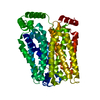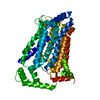[English] 日本語
 Yorodumi
Yorodumi- PDB-8y65: Cryo-EM structure of human urate transporter GLUT9 bound to subst... -
+ Open data
Open data
- Basic information
Basic information
| Entry | Database: PDB / ID: 8y65 | |||||||||
|---|---|---|---|---|---|---|---|---|---|---|
| Title | Cryo-EM structure of human urate transporter GLUT9 bound to substrate urate | |||||||||
 Components Components | Solute carrier family 2, facilitated glucose transporter member 9 | |||||||||
 Keywords Keywords | TRANSPORT PROTEIN / GLUT9 / Urate | |||||||||
| Function / homology |  Function and homology information Function and homology informationDefective SLC2A9 causes hypouricemia renal 2 (RHUC2) / fructose transmembrane transporter activity / hexose transmembrane transporter activity / monosaccharide transmembrane transport / fructose transmembrane transport / hexose transmembrane transport / carbohydrate:proton symporter activity / Cellular hexose transport / glucose transmembrane transporter activity / urate transport ...Defective SLC2A9 causes hypouricemia renal 2 (RHUC2) / fructose transmembrane transporter activity / hexose transmembrane transporter activity / monosaccharide transmembrane transport / fructose transmembrane transport / hexose transmembrane transport / carbohydrate:proton symporter activity / Cellular hexose transport / glucose transmembrane transporter activity / urate transport / urate metabolic process / glucose transmembrane transport / urate transmembrane transporter activity / transmembrane transporter activity / basolateral plasma membrane / apical plasma membrane / membrane / plasma membrane Similarity search - Function | |||||||||
| Biological species |  Homo sapiens (human) Homo sapiens (human) | |||||||||
| Method | ELECTRON MICROSCOPY / single particle reconstruction / cryo EM / Resolution: 3.51 Å | |||||||||
 Authors Authors | Pan, X.J. / Shen, Z.L. / Xu, L. / Huang, G.X.Y. | |||||||||
| Funding support |  China, 2items China, 2items
| |||||||||
 Citation Citation |  Journal: Nat Commun / Year: 2024 Journal: Nat Commun / Year: 2024Title: Structural basis for urate recognition and apigenin inhibition of human GLUT9. Authors: Zilin Shen / Li Xu / Tong Wu / Huan Wang / Qifan Wang / Xiaofei Ge / Fang Kong / Gaoxingyu Huang / Xiaojing Pan /  Abstract: Urate, the physiological form of uric acid and a potent antioxidant in serum, plays a pivotal role in scavenging reactive oxygen species. Yet excessive accumulation of urate, known as hyperuricemia, ...Urate, the physiological form of uric acid and a potent antioxidant in serum, plays a pivotal role in scavenging reactive oxygen species. Yet excessive accumulation of urate, known as hyperuricemia, is the primary risk factor for the development of gout. The high-capacity urate transporter GLUT9 represents a promising target for gout treatment. Here, we present cryo-electron microscopy structures of human GLUT9 in complex with urate or its inhibitor apigenin at overall resolutions of 3.5 Å and 3.3 Å, respectively. In both structures, GLUT9 exhibits an inward open conformation, wherein the substrate binding pocket faces the intracellular side. These structures unveil the molecular basis for GLUT9's substrate preference of urate over glucose, and show that apigenin acts as a competitive inhibitor by occupying the substrate binding site. Our findings provide critical information for the development of specific inhibitors targeting GLUT9 as potential therapeutics for gout and hyperuricemia. | |||||||||
| History |
|
- Structure visualization
Structure visualization
| Structure viewer | Molecule:  Molmil Molmil Jmol/JSmol Jmol/JSmol |
|---|
- Downloads & links
Downloads & links
- Download
Download
| PDBx/mmCIF format |  8y65.cif.gz 8y65.cif.gz | 93 KB | Display |  PDBx/mmCIF format PDBx/mmCIF format |
|---|---|---|---|---|
| PDB format |  pdb8y65.ent.gz pdb8y65.ent.gz | 67.3 KB | Display |  PDB format PDB format |
| PDBx/mmJSON format |  8y65.json.gz 8y65.json.gz | Tree view |  PDBx/mmJSON format PDBx/mmJSON format | |
| Others |  Other downloads Other downloads |
-Validation report
| Summary document |  8y65_validation.pdf.gz 8y65_validation.pdf.gz | 1.1 MB | Display |  wwPDB validaton report wwPDB validaton report |
|---|---|---|---|---|
| Full document |  8y65_full_validation.pdf.gz 8y65_full_validation.pdf.gz | 1.1 MB | Display | |
| Data in XML |  8y65_validation.xml.gz 8y65_validation.xml.gz | 26.6 KB | Display | |
| Data in CIF |  8y65_validation.cif.gz 8y65_validation.cif.gz | 38.3 KB | Display | |
| Arichive directory |  https://data.pdbj.org/pub/pdb/validation_reports/y6/8y65 https://data.pdbj.org/pub/pdb/validation_reports/y6/8y65 ftp://data.pdbj.org/pub/pdb/validation_reports/y6/8y65 ftp://data.pdbj.org/pub/pdb/validation_reports/y6/8y65 | HTTPS FTP |
-Related structure data
| Related structure data |  38966MC  8y66C M: map data used to model this data C: citing same article ( |
|---|---|
| Similar structure data | Similarity search - Function & homology  F&H Search F&H Search |
- Links
Links
- Assembly
Assembly
| Deposited unit | 
|
|---|---|
| 1 |
|
- Components
Components
| #1: Protein | Mass: 63215.090 Da / Num. of mol.: 1 Source method: isolated from a genetically manipulated source Source: (gene. exp.)  Homo sapiens (human) / Gene: SLC2A9, GLUT9 / Production host: Homo sapiens (human) / Gene: SLC2A9, GLUT9 / Production host:  Homo sapiens (human) / References: UniProt: Q9NRM0 Homo sapiens (human) / References: UniProt: Q9NRM0 |
|---|---|
| #2: Chemical | ChemComp-URC / |
| Has ligand of interest | Y |
-Experimental details
-Experiment
| Experiment | Method: ELECTRON MICROSCOPY |
|---|---|
| EM experiment | Aggregation state: PARTICLE / 3D reconstruction method: single particle reconstruction |
- Sample preparation
Sample preparation
| Component | Name: GLUT9 in complex with urate / Type: COMPLEX / Entity ID: #1 / Source: RECOMBINANT |
|---|---|
| Source (natural) | Organism:  Homo sapiens (human) Homo sapiens (human) |
| Source (recombinant) | Organism:  Homo sapiens (human) Homo sapiens (human) |
| Buffer solution | pH: 6 |
| Specimen | Conc.: 1 mg/ml / Embedding applied: NO / Shadowing applied: NO / Staining applied: NO / Vitrification applied: YES |
| Vitrification | Cryogen name: ETHANE / Humidity: 100 % |
- Electron microscopy imaging
Electron microscopy imaging
| Experimental equipment |  Model: Titan Krios / Image courtesy: FEI Company |
|---|---|
| Microscopy | Model: FEI TITAN KRIOS |
| Electron gun | Electron source:  FIELD EMISSION GUN / Accelerating voltage: 300 kV / Illumination mode: FLOOD BEAM FIELD EMISSION GUN / Accelerating voltage: 300 kV / Illumination mode: FLOOD BEAM |
| Electron lens | Mode: BRIGHT FIELD / Nominal defocus max: 1800 nm / Nominal defocus min: 1500 nm |
| Image recording | Average exposure time: 2.56 sec. / Electron dose: 50 e/Å2 / Film or detector model: GATAN K3 (6k x 4k) |
- Processing
Processing
| EM software | Name: PHENIX / Version: 1.19.2_4158: / Category: model refinement | ||||||||||||||||||||||||
|---|---|---|---|---|---|---|---|---|---|---|---|---|---|---|---|---|---|---|---|---|---|---|---|---|---|
| CTF correction | Type: PHASE FLIPPING AND AMPLITUDE CORRECTION | ||||||||||||||||||||||||
| 3D reconstruction | Resolution: 3.51 Å / Resolution method: FSC 0.143 CUT-OFF / Num. of particles: 810830 / Symmetry type: POINT | ||||||||||||||||||||||||
| Refine LS restraints |
|
 Movie
Movie Controller
Controller



 PDBj
PDBj




